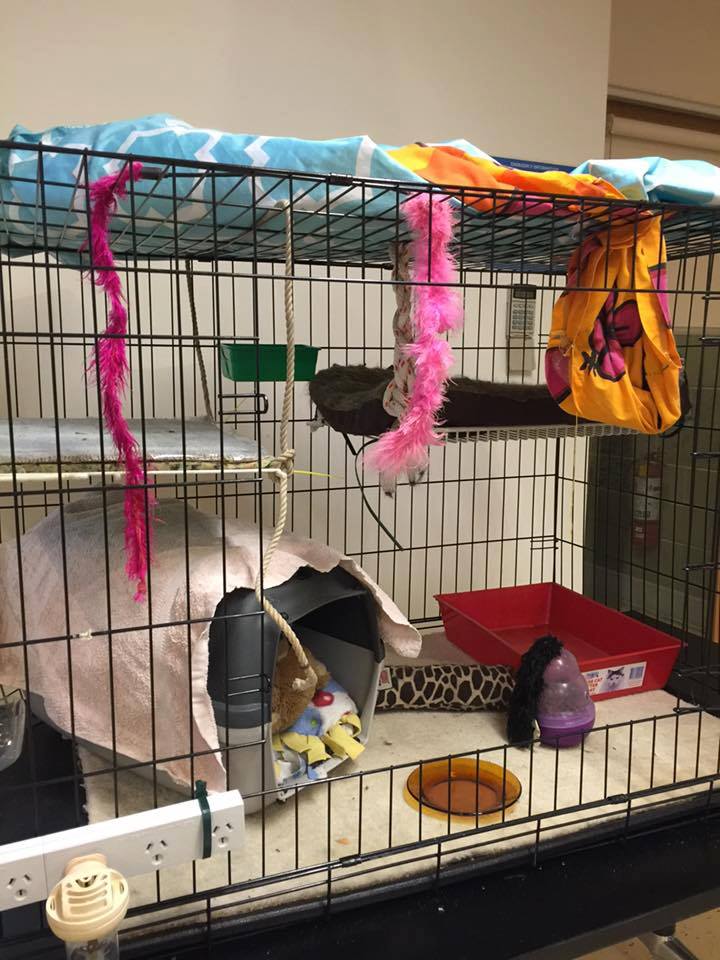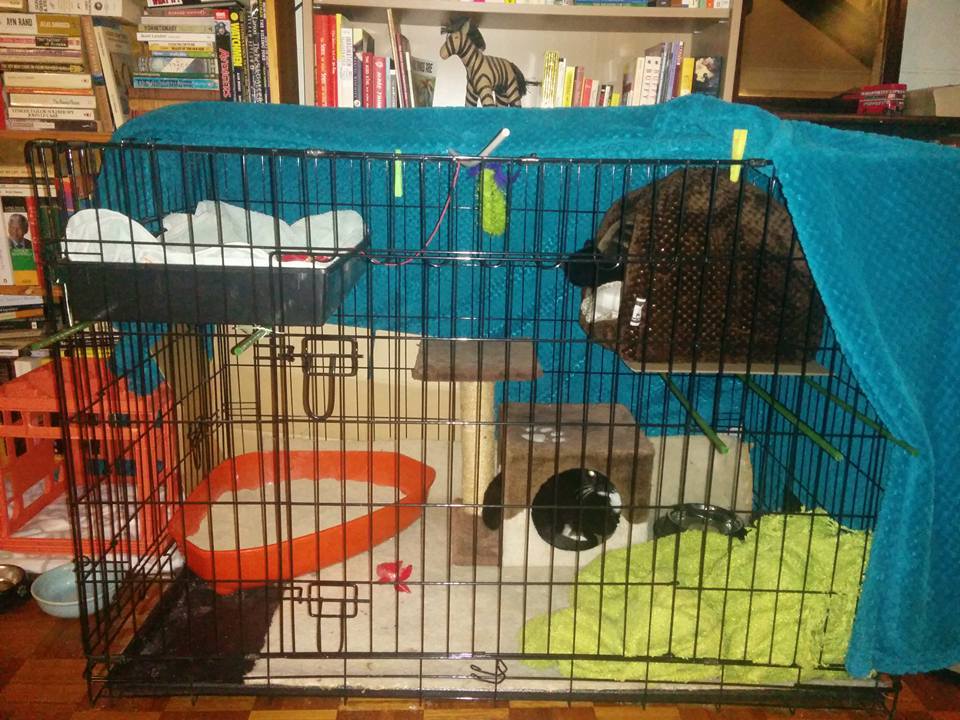On this page
- Why they need a sanctuary space
- Sanctuary space options
- I don’t want to put them in a crate!
- How to tell whether to use a crate or a room
- Using a crate
- Using a room
- Keep them safe – don’t lose them!
Why do they need to start in a sanctuary space?
Imagine finding yourself in a strange place with giant monsters. You may have seen them from a distance, but you have never had a close encounter with them. If you have, it may not have been good. You may even have seen some of your friends, or family members, treated cruelly or killed by them.
Would you learn to trust them quicker if you were constantly trying to run away from them, or if you were confined to a set area where nothing bad happened to you?
To an unsocialised cat, you are the giant monster. They get used to us giant human monsters quickest if they’re confined to a small area, which will become their new ‘territory’.
Sanctuary space options
Depending on how frightened they are, their sanctuary space can either be a comfortable room, like a bedroom, or a 42 -48″ wire dog crate.
If they start off in a crate, they’ll ‘graduate’ to a room once they’ve reached certain milestones, before graduating to the rest of the house.
But I don’t want to put them in a crate!
Having your cat in a socialisation crate may seem really weird at first. You might even think it’s unkind.
Think of it like this: if you were to break your leg, you’d probably get a cast so that the bone sets properly.
Having your leg in a cast will be limiting. You won’t be able to do things you normally do; showering will be fun; and you’ll get really itchy. But without the cast, you may end up permanently impaired, never able to walk without pain or live the life you’re used to. The cast means a temporary loss of quality of life for long-term good quality of life.
Using a crate is similar. Your scaredy cat will overcome their fear of people, feel safe in their foster home and be able to strut their stuff to adopters much sooner. They won’t be living in a perpetual state of fear and will be able to enjoy being waited on by their loving human servant.
Many a time, we have observed foster carers who were reluctant to use a crate feel frustrated that their timid cat wasn’t making progress. Once they tried a crate, their foster kitty came along in leaps and bounds.
How to tell whether to use a crate or room
Whether you need a crate or a room will depend on how frightened they are.
When we welcome a new foster cat, if we know that they’re timid (the pound or shelter will usually have some idea), we tend to start them off in a crate so that we can assess them. It’s much, much, much easier, and less stressful for them, to let them out of a crate into a room than get them into a crate when they’re paralysed with fear under a bed!
You might be able to get an idea of their fear level when they’re still in the carrier, through their body language.
You could start them off in a room and, if they’re not making any progress after a couple of weeks, move them to a crate. Just be aware that that is easier said than done.
Using a crate
Collapsible wire dog crates are convenient, inexpensive and easy to disinfect. We recommend the XXL size (48″) or 42″. Your cat may be in there for a while, so it’s important that they have room to move and can get at least some exercise.
These are cheapest to buy online. They come with a plastic tray that can be slid out and doors on two or three sides.

Location, location, location: Where to put the crate
Put the crate where you and your family spend most of your time, so they’re exposed to all the household goings-on – living room, your bedroom, your office etc.
Give them a nice view
If at all possible, position it so they have a view to the outside – trees, birds, pedestrians. They will be happier if they have something interesting to look at and keep their mind occupied.
Have the crate off the ground
Place the crate two to three feet off the ground, so you don’t tower over them. Coffee table, dining table, desk, bricks, milk crates, storage tubs all work.

Karyn and Brodie use milk crates to give height. Two crates have been linked, to give more space. The photo was taken at night, with the blind down, but the right side has a view from a window.
What to put in the crate
- Igloo, or carrier with pillow, at the back of the crate, so that they can hide until they feel safe. A cardboard box turned on its side also works. A milk crate on its side, with a small pillow in it, and covered with a towel can be used as an igloo, bed to sleep on top of and launching place to get to the shelf
- Litter tray If they’ve come straight from the streets, cat litter may be strange for them. You can give them one less change to adjust to by starting off putting soil, or potting mix, in the tray instead of cat litter
- Food and water (if they’re a messy litter tray user, use water bowls that clip on to the crate sides. You can make water bowls by cutting up a 1L V8 juice bottle, punching two holes in one side using a hole punch, and hanging it on the sides using S hooks)

Water bowl, made from V8 juice bottle
- Scratching post attached to side of crate – carpet glued onto wood; flat cardboard one; solid piece of bark. Drill holes into corners and attach with cable ties or rope
- One or two shelves or hammocks to give them a high place and more territory. Wire fridge shelves, from hard waste/nature strips, work well – cover with a sheet of cardboard then carpet underlay or carpet, cable-tied to it. Attach the shelf to the crate sides using cable ties or rope. You can get removable cable ties from the garden section of hardware stores
- Dangly toys – feathers, lattice balls, bungy mouse, rope – tied to top of crate. Avoid using string. A ball in a track is also a good toy
- Cat grass to nibble on Buy it from a nursery or hardware store
- Familiar scents Cats have an incredible sense of smell. Familiar scents will lower their stress. If you know where they came from, collect some soil, and/or plants, from their former home. Put the soil in a pillow case and near their igloo. Shake it up now and then. Place the plant cuttings throughout their crate.
Some crate setups

Akasha’s setup has a hiding place and a semi-enclosed bed for when she is more confident.

Kirra loved her large igloo, on top of the shelf. She could hide and be up high at the same time!

Amber and Charlie came into care in the middle of winter. A cardboard lettuce box, with one side cut off, meant they could have a heated bed and a room with a view.

Brothers Zimba and Zebedee weren’t as frightened as some and didn’t need a hiding place. They loved sleeping together in their ‘double bed’.

Siblings Ambrose and Sheridan had two shelves, a hiding place and a double bed. They slept on top of the hiding place, instead of in it, once they were settled.

Feliway diffuser, Kong Wobbler and a Kickaroo toy reduce stress and give some stimulation. A carpet offcut on top of the tray means they don’t have to walk on plastic.

Karyn and Brodie have been creative in making unusual beds. Again, height is used to help cats feel safer.
Using a room
If they’re not too terrified of humans, they can start off in a small comfortable room, with the door kept closed. Even better, stack two extra tall baby gates on top of each other, and leave the wooden door open. They can then see, hear and smell the rest of the household and are less isolated.

Two extra tall baby gates, stacked on top of each other, confine your scaredy cat and mean they can see and hear the rest of the household.
Depending on how frightened they are, they may take longer to socialize than if confined to a crate.
What to put in their room
In their room, give them everything you would in the crate, and more:
- Several hiding places so that they can hide until they feel safe:
- wardrobe with one door left open
- a deep igloo
- large cardboard box turned on its side with a pillow in it
- milk crate on its side, with a small pillow in it, and covered with a towel
- cat carrier with a pillow in it and covered with a towel
- Litter tray
- Food and water
- Stable scratching post – the taller the better
- Toys – feathers, balls, bungy mouse, ball in a track
- Cat grass to nibble on from a nursery or hardware store
- Familiar scents Cats have an incredible sense of smell. Familiar scents will lower their stress. If you know where they came from, collect some soil, and/or plants, from their former home. Put the soil in a pillow case and near their hiding places. Shake it up now and then. Place the plant cuttings throughout their room
- Perching spots to look out the window (remember to have window open a maximum of 1-2cm!)
It’s best if they can’t hide in inaccessible places e.g under a bed, behind a wardrobe.
Keep them safe!
Make sure you don’t have windows open more than 2cm, or they may get out. Check that a cat can’t push windows further open.
This is very important even if they’re in a crate – believe it or not, they can get out of a crate if they’re determined enough! Timid cats are very hard to find once they’re out of a home and you’ll usually need to search for them – for days, weeks or months. Prevention is waaaay better than cure.



